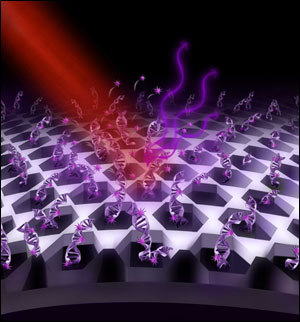
Nanoparticles Enable Drug Activation by NIR Light
SINGAPORE, Sept. 28, 2012 — Nanoparticles that convert near-infrared to ultraviolet or visible light could help overcome the skin penetration limits of conventional photodynamic therapy.
Photodynamic therapy (PDT) uses visible light — usually in the red wavelength — to activate a light-sensitive drug but is limited to a penetration depth of about 1 cm. Because of this, PDT is currently used to treat certain types of cancer just under the skin, such as in the esophagus. It generally can’t be used to treat cancers that have spread or large tumors.
The new technique, developed at the National University of Singapore, manipulates gene expression by using nanoparticles to convert near-infrared (NIR) to UV or visible light could offer a safe, noninvasive therapy for deeper cancers.

A team at the National University of Singapore uses nanoparticles to convert near-infrared light to the visible or ultraviolet wavelengths to allow cancer treatments such as photodynamic therapy (PDT) to penetrate deeper into tissue. Courtesy of Muthu Kumara Gnananasammandhan.
“NIR, besides being nontoxic, is also able to penetrate deeper into our tissues,” said associate professor and team leader Zhang Yong. “When NIR reaches the desired places in the body of the patient, the nanoparticles which we have invented are able to convert the NIR back to UV light (up-conversion) to effectively activate the genes in the way desired — by controlling the amount of proteins expressed each time, when this should take place, as well as how long it should take place.”
The researchers successfully controlled gene expression and hindered tumor growth in mice and were also able to target the nanoparticles to specific locations. The method can be customized for a wide range of applications, such as PDT or bioimaging, they said.
The team now is working with the National Cancer Center Singapore to evaluate the technique’s efficacy and safety for clinical trials. It is also developing point-of-care diagnostics for detecting biomarkers and bacteria.
For more information, visit: www.nus.edu.sg
Published: September 2012